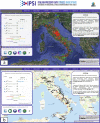Database of Italian present-day stress indicators, IPSI 1.4
- PMID: 32901031
- PMCID: PMC7479623
- DOI: 10.1038/s41597-020-00640-w
Database of Italian present-day stress indicators, IPSI 1.4
Abstract
The Italian Present-day Stress Indicators (IPSI) database is a freely available Italian georeferenced repository of information regarding the crustal stress field. It consists of horizontal stress orientations that have been analysed, compiled in a standardised format and quality-ranked for reliability and comparability on a global scale. The database contains a collection of information regarding contemporary stress within the shallow crust from the following main stress-indicator categories: borehole breakouts; earthquake focal mechanisms; seismic sequences and active fault-slip data. The present database (IPSI 1.4) released in January 2020 is accessible through a web interface which facilitates findability, accessibility, interoperability and reusability of the dataset. Moreover, it contains 928 records updated up until December 2019 with an increase of 10% with respect to the first one, and improved metadata information. The uniform spread of stress data over a given territory is relevant for earth crustal modelling or as starting point in many applied studies. It is therefore necessary to continue collecting new data and update present-day stress maps to obtain more reliable evaluations.
Conflict of interest statement
The authors declare no competing interests.
Figures




References
-
- Mariucci MT, Montone P. 2017. IPSI 1.0, Database of Italian Present-day Stress Indicators. Istituto Nazionale di Geofisica e Vulcanologia (INGV) - DOI
-
- Montone P, Mariucci MT. Active stress in the NE external margin of the Apennines: the Ferrara arc, northern Italy. J. Geodyn. 1999;28(2-3):251–265.
-
- Mariucci MT, Amato A, Gambini R, Giorgioni M, Montone P. Along-depth stress rotations and active faults: an example in a 5-km deep well of southern Italy. Tectonics. 2002;21(4):1021.
-
- Heidbach O, 2016. World Stress Map Database Release 2016. GFZ Data Services. - DOI
LinkOut - more resources
Full Text Sources

